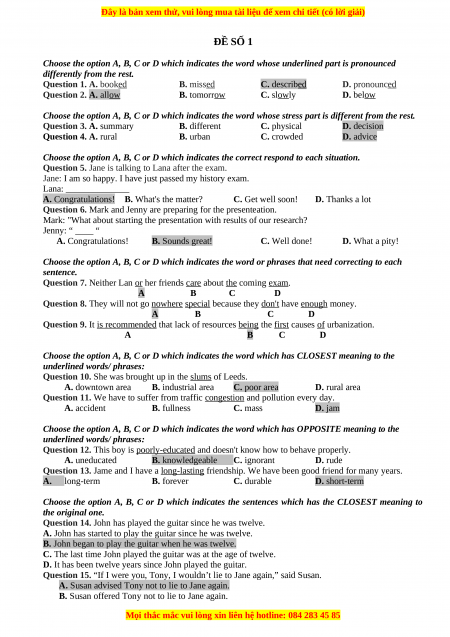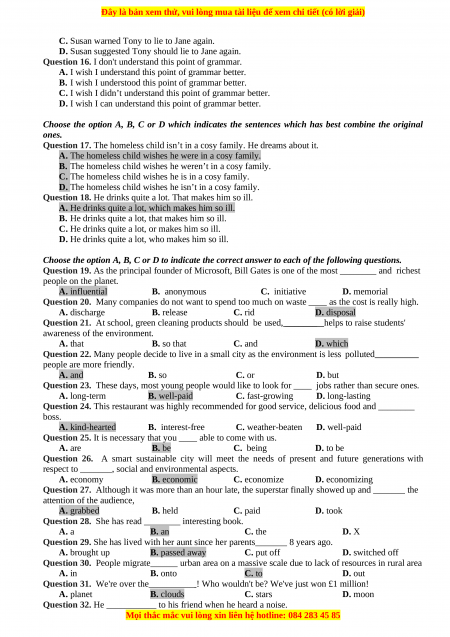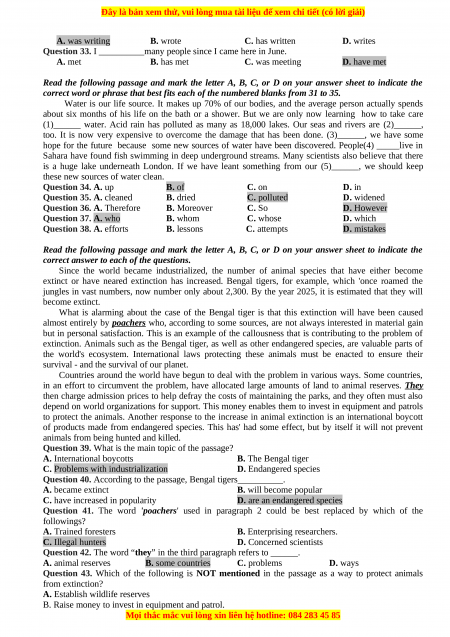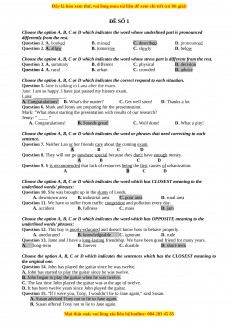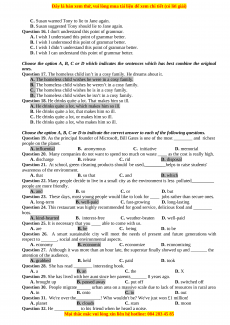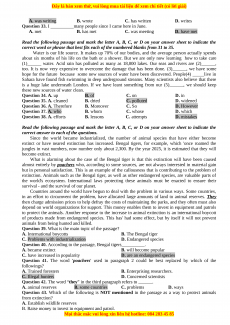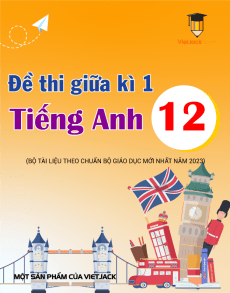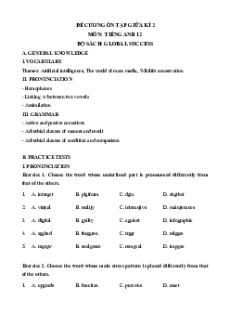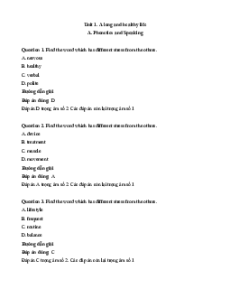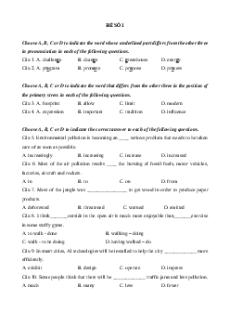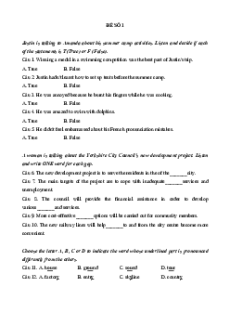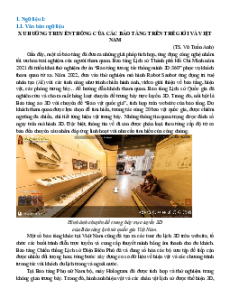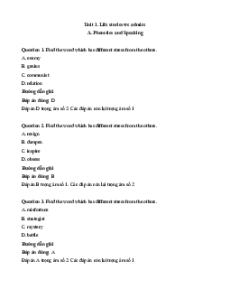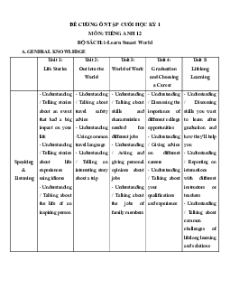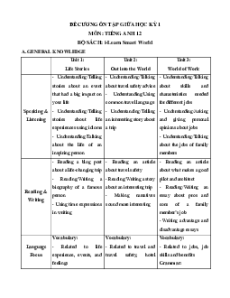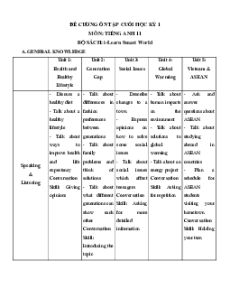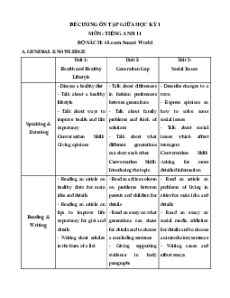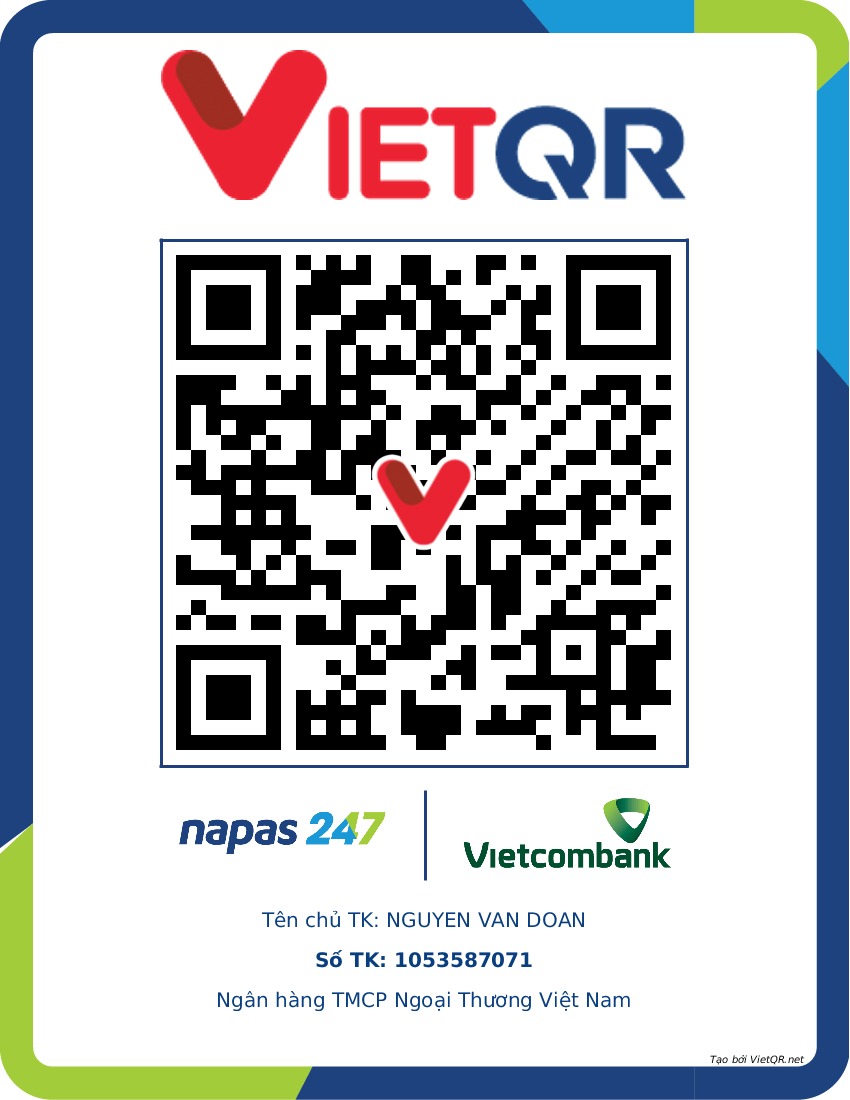ĐỀ SỐ 1
Choose the option A, B, C or D which indicates the word whose underlined part is pronounced differently from the rest.
Question 1. A. booked B. missed C. described D. pronounced
Question 2. A. allow B. tomorrow C. slowly D. below
Choose the option A, B, C or D which indicates the word whose stress part is different from the rest.
Question 3. A. summary B. different C. physical D. decision Question 4. A. rural B. urban C. crowded D. advice
Choose the option A, B, C or D which indicates the correct respond to each situation.
Question 5. Jane is talking to Lana after the exam.
Jane: I am so happy. I have just passed my history exam. Lana: ______________
A. Congratulations! B. What's the matter? C. Get well soon! D. Thanks a lot
Question 6. Mark and Jenny are preparing for the presenteation.
Mark: "What about starting the presentation with results of our research? Jenny: “ ____ “ A. Congratulations! B. Sounds great! C. Well done! D. What a pity!
Choose the option A, B, C or D which indicates the word or phrases that need correcting to each sentence.
Question 7. Neither Lan or her friends care about the coming exam. A B C D
Question 8. They will not go nowhere special because they don't have enough money. A B C D
Question 9. It is recommended that lack of resources being the first causes of urbanization. A B C D
Choose the option A, B, C or D which indicates the word which has CLOSEST meaning to the underlined words/ phrases:
Question 10. She was brought up in the slums of Leeds. A. downtown area B. industrial area C. poor area D. rural area
Question 11. We have to suffer from traffic congestion and pollution every day. A. accident B. fullness C. mass D. jam
Choose the option A, B, C or D which indicates the word which has OPPOSITE meaning to the underlined words/ phrases:
Question 12. This boy is poorly-educated and doesn't know how to behave properly. A. uneducated B. knowledgeable C. ignorant D. rude
Question 13. Jame and I have a long-lasting friendship. We have been good friend for many years. A. long-term B. forever C. durable D. short-term
Choose the option A, B, C or D which indicates the sentences which has the CLOSEST meaning to the original one.
Question 14. John has played the guitar since he was twelve.
A. John has started to play the guitar since he was twelve.
B. John began to play the guitar when he was twelve.
C. The last time John played the guitar was at the age of twelve.
D. It has been twelve years since John played the guitar.
Question 15. “If I were you, Tony, I wouldn’t lie to Jane again,” said Susan.
A. Susan advised Tony not to lie to Jane again.
B. Susan offered Tony not to lie to Jane again.
C. Susan warned Tony to lie to Jane again.
D. Susan suggested Tony should lie to Jane again.
Question 16. I don't understand this point of grammar.
A. I wish I understand this point of grammar better.
B. I wish I understood this point of grammar better.
C. I wish I didn’t understand this point of grammar better.
D. I wish I can understand this point of grammar better.
Choose the option A, B, C or D which indicates the sentences which has best combine the original ones.
Question 17. The homeless child isn’t in a cosy family. He dreams about it.
A. The homeless child wishes he were in a cosy family.
B. The homeless child wishes he weren’t in a cosy family.
C. The homeless child wishes he is in a cosy family.
D. The homeless child wishes he isn’t in a cosy family.
Question 18. He drinks quite a lot. That makes him so ill.
A. He drinks quite a lot, which makes him so ill.
B. He drinks quite a lot, that makes him so ill.
C. He drinks quite a lot, or makes him so ill.
D. He drinks quite a lot, who makes him so ill.
Choose the option A, B, C or D to indicate the correct answer to each of the following questions.
Question 19. As the principal founder of Microsoft, Bill Gates is one of the most ________ and richest people on the planet. A. influential B. anonymous C. initiative D. memorial
Question 20. Many companies do not want to spend too much on waste ____ as the cost is really high. A. discharge B. release C. rid D. disposal
Question 21. At school, green cleaning products should be used, _______ helps to raise students' awareness of the environment. A. that B. so that C. and D. which
Question 22. Many people decide to live in a small city as the environment is less polluted people are more friendly. A. and B. so C. or D. but
Question 23. These days, most young people would like to look for ____ jobs rather than secure ones. A. long-term B. well-paid C. fast-growing D. long-lasting
Question 24. This restaurant was highly recommended for good service, delicious food and ________ boss. A. kind-hearted B. interest-free C. weather-beaten D. well-paid
Question 25. It is necessary that you ____ able to come with us. A. are B. be C. being D. to be
Question 26. A smart sustainable city will meet the needs of present and future generations with
respect to _______, social and environmental aspects. A. economy B. economic C. economize D. economizing
Question 27. Although it was more than an hour late, the superstar finally showed up and _______ the attention of the audience, A. grabbed B. held C. paid D. took
Question 28. She has read ________ interesting book. A. a B. an C. the D. X
Question 29. She has lived with her aunt since her parents_______ 8 years ago. A. brought up B. passed away C. put off D. switched off
Question 30. People migrate______ urban area on a massive scale due to lack of resources in rural area A. in B. onto C. to D. out
Question 31. We're over the__________ ! Who wouldn't be? We've just won £1 million! A. planet B. clouds C. stars D. moon
Question 32. He ___________ to his friend when he heard a noise.
A. was writing B. wrote C. has written D. writes
Question 33. I __________many people since I came here in June. A. met B. has met C. was meeting D. have met
Read the following passage and mark the letter A, B, C, or D on your answer sheet to indicate the
correct word or phrase that best fits each of the numbered blanks from 31 to 35.
Water is our life source. It makes up 70% of our bodies, and the average person actually spends
about six months of his life on the bath or a shower. But we are only now learning how to take care
(1)______ water. Acid rain has polluted as many as 18,000 lakes. Our seas and rivers are (2)______,
too. It is now very expensive to overcome the damage that has been done. (3)______, we have some
hope for the future because some new sources of water have been discovered. People(4) _____live in
Sahara have found fish swimming in deep underground streams. Many scientists also believe that there
is a huge lake underneath London. If we have leant something from our (5)______, we should keep
these new sources of water clean.
Question 34. A. up B. of C. on D. in
Question 35. A. cleaned B. dried C. polluted D. widened
Question 36. A. Therefore B. Moreover C. So D. However
Question 37. A. who B. whom C. whose D. which
Question 38. A. efforts
B. lessons C. attempts D. mistakes
Read the following passage and mark the letter A, B, C, or D on your answer sheet to indicate the
correct answer to each of the questions.
Since the world became industrialized, the number of animal species that have either become
extinct or have neared extinction has increased. Bengal tigers, for example, which 'once roamed the
jungles in vast numbers, now number only about 2,300. By the year 2025, it is estimated that they will become extinct.
What is alarming about the case of the Bengal tiger is that this extinction will have been caused
almost entirely by poachers who, according to some sources, are not always interested in material gain
but in personal satisfaction. This is an example of the callousness that is contributing to the problem of
extinction. Animals such as the Bengal tiger, as well as other endangered species, are valuable parts of
the world's ecosystem. International laws protecting these animals must be enacted to ensure their
survival - and the survival of our planet.
Countries around the world have begun to deal with the problem in various ways. Some countries,
in an effort to circumvent the problem, have allocated large amounts of land to animal reserves. They
then charge admission prices to help defray the costs of maintaining the parks, and they often must also
depend on world organizations for support. This money enables them to invest in equipment and patrols
to protect the animals. Another response to the increase in animal extinction is an international boycott
of products made from endangered species. This has' had some effect, but by itself it will not prevent
animals from being hunted and killed.
Question 39. What is the main topic of the passage?
A. International boycotts B. The Bengal tiger
C. Problems with industrialization D. Endangered species
Question 40. According to the passage, Bengal tigers__________. A. became extinct B. will become popular
C. have increased in popularity
D. are an endangered species
Question 41. The word 'poachers' used in paragraph 2 could be best replaced by which of the followings? A. Trained foresters
B. Enterprising researchers. C. Illegal hunters D. Concerned scientists
Question 42. The word “they” in the third paragraph refers to ______. A. animal reserves B. some countries C. problems D. ways
Question 43. Which of the following is NOT mentioned in the passage as a way to protect animals from extinction?
A. Establish wildlife reserves
B. Raise money to invest in equipment and patrol.
C. Introduce laws to prohibit the killing of endangered animals.
D. boycott animal products
Read the following passage and mark the letter A, B, C, or D on your answer sheet to indicate the
correct answer to each of the questions.
Along with the rapid growth of the national economy and increased living standards, the use of
disposables and over-packaged products has become common, which causes a waste of resources, and
brings about a negative impact on the environment. Many countries have started to act to control the use
of disposables and over-packaged, products.
In 1994, the Ministry of Environment in Korea has put restrictions on packaging methods.
Korea's legal regulations require businesses to restrict their use of disposable products by reducing
unnecessary packaging materials or not giving them out to customers for free. The use of materials are
difficult to recycle is also prohibited.
Thanks to development of technology, biodegradable materials were invented to produce
packaging products. They are able to decay naturally by bacteria. Therefore, biodegradable packaging
helps to limit the amount of harmful chemicals released into the environment. In 2008, biodegradable
bags were put in use in most of the supermarkets in Korea. Paper cups and paper bags are also given to
shoppers for free, but in a limited use.
The ministry also established the detailed Guidelines on the Restrictions of Use of Disposable
Products in order to ensure that local governments could conduct systematic checks and inspections of
businesses, and implemented reductions on over-packaged products during national holidays, and school
admission and graduation seasons.
(Text adapted from h ttp://eng.me.go. kr/eng/web/index. do?menuld=383)
Question 44. What could be the best title of the text?
A. The Impacts of Disposable Products
B. Korea's Ministry of Environment
C. Disposable Products and Over-packaging
D. Disposable Products and Holidays in Korea
Question 45. What is the result of overusing disposable products in packaging?
A. The environment will be badly affected.
B. Natural resources are not exploited.
C. Businesses gain more profits.
D. Living standards increase.
Question 46. When did Korea started restrictions on packaging products? A. In 1994 B. In 2008 C. In the 19th century D. In the 21st century
Question 47. The word ‘restrict’ in the second paragraph most closely means ? A. ban B. dispose C. limit D. suggest
Question 48. What does the word “them” in the second paragraph refer to? A. regulations B. packaging materials C. companies' products D. packaging methods
Question 49. According to the text, what is the product of the advanced technology used in packaging? A. various chemicals B. paper packaging C. packaging products
D. naturally-decomposing materials
Question 50. According to the text, what is the purpose of introducing detailed Guidelines on the
Restrictions of Use of Disposable Products?
A. to require systematic improvement in packaging
B. to implement special policy of packaging on holidays
C. to increase the excess use of packaging materials on holidays
D. to implement security policies on holidays -----HẾT-----
Đề thi giữa kì học 1 Tiếng anh 12 năm 2022 - 2023 (Đề 1)
0.9 K
451 lượt tải
MUA NGAY ĐỂ XEM TOÀN BỘ TÀI LIỆU
CÁCH MUA:
- B1: Gửi phí vào TK:
1133836868- CT TNHH DAU TU VA DV GD VIETJACK - Ngân hàng MB (QR) - B2: Nhắn tin tới Zalo VietJack Official ( nhấn vào đây ) để xác nhận thanh toán và tải tài liệu - giáo án
Liên hệ ngay Hotline hỗ trợ: 084 283 45 85
Đề thi được cập nhật liên tục trong gói này từ nay đến hết tháng 6/2023. Chúng tôi đảm bảo đủ số lượng đề đã cam kết hoặc có thể nhiều hơn, tất cả có BẢN WORD, LỜI GIẢI CHI TIẾT và tải về dễ dàng.
Để tải tài liệu gốc về máy bạn click vào nút Tải Xuống ở trên!
Thuộc bộ (mua theo bộ để tiết kiệm hơn):
- Tailieugiaovien.com.vn giới thiệu bộ 7 đề thi giữa học kì 1 môn Tiếng Anh lớp 12 bao gồm: 3 đề thi giữa kì 1 có đáp án; 1 đề cương ôn tập giữa kì và 4 đề thi giữa kì 1 không có đáp án mới nhất năm 2022 - 2023 nhằm giúp Giáo viên có thêm tài liệu tham khảo ra đề thi Tiếng anh lớp 12.
- File word có lời giải chi tiết 100%.
- Mua trọn bộ sẽ tiết kiệm hơn tải lẻ 50%.
Đánh giá
4.6 / 5(901 )5
4
3
2
1
Trọng Bình
Tài liệu hay
Giúp ích cho tôi rất nhiều
Duy Trần
Tài liệu chuẩn
Rất thích tài liệu bên VJ soạn (bám sát chương trình dạy)
TÀI LIỆU BỘ BÁN CHẠY MÔN Tiếng Anh
Xem thêmTÀI LIỆU BỘ BÁN CHẠY Lớp 12
Xem thêmTài liệu bộ mới nhất

Đây là bản xem thử, vui lòng mua tài liệu để xem chi tiết (có lời giải)
ĐỀ SỐ 1
Choose the option A, B, C or D which indicates the word whose underlined part is pronounced
differently from the rest.
Question 1.A. B. C. D.
Question 2.A. B. C. D.
Choose the option A, B, C or D which indicates the word whose stress part is different from the rest.
Question 3.A. B. C. D.
Question 4. A. B. C. D.
Choose the option A, B, C or D which indicates the correct respond to each situation.
Question 5.
A. ! B."#$ C.%! D.&
Question 6.'
'("$
))
A. ! B.*! C."! D."!
Choose the option A, B, C or D which indicates the word or phrases that need correcting to each
sentence.
Question 7.+
A B C D
Question 8.&#
A B C D
Question 9.,
A B C D
Choose the option A, B, C or D which indicates the word which has CLOSEST meaning to the
underlined words/ phrases:
Question 10.*
A. B. C. D.
Question 11. "
A. B. C. D.
Choose the option A, B, C or D which indicates the word which has OPPOSITE meaning to the
underlined words/ phrases:
Question 12.&-#
A. B. C. D.
Question 13. -"
A. - B. C. D.-
Choose the option A, B, C or D which indicates the sentences which has the CLOSEST meaning to
the original one.
Question 14.
A.
B.
C.&
D.
Question 15. ).&./.0*
A.*&
B.*&
Mọi thắc mắc vui lòng xin liên hệ hotline: 084 283 45 85

Đây là bản xem thử, vui lòng mua tài liệu để xem chi tiết (có lời giải)
C.*&
D.*&
Question 16. #
A.
B.
C. /
D.
Choose the option A, B, C or D which indicates the sentences which has best combine the original
ones.
Question 17. &/1
A. &
B. &/
C. &
D. &/
Question 18. 12&
A. 12.
B. 12.
C. 12.
D. 12.
Choose the option A, B, C or D to indicate the correct answer to each of the following questions.
Question 19. 3'.4%55
A. B. C. D.
Question 20. '
A. B. C. D.
Question 21. 3. .#
A. B. C. D.
Question 22. '
A. B. C. D.
Question 23. &.
A.- B.- C.- D.-
Question 24. &.
A.- B.- C.- D.-
Question 25.
A. B. C. D.
Question 26. 3 5
.
A. B. C., D.,
Question 27. 3.5
.
A. B.5 C.5 D.
Question 28. *
A. B. C. D.6
Question 29. *7
A. B. C. D.
Question 30. 8
A. B. C. D.
Question 31. "#5!"#$"#9:!
A. B. C. D.
Question 32. 1
Mọi thắc mắc vui lòng xin liên hệ hotline: 084 283 45 85

Đây là bản xem thử, vui lòng mua tài liệu để xem chi tiết (có lời giải)
A. B. C. D.
Question 33.
A. B. C. D.
Read the following passage and mark the letter A, B, C, or D on your answer sheet to indicate the
correct word or phrase that best fits each of the numbered blanks from 31 to 35.
";<=.
4
>:?3:7.<<<@ >A?.
>B?.
8>C?
*'
>D?.
Question 34.A. B. C. D.
Question 35.A. B. C. D.
Question 36.A. & B. ' C. * D. 1
Question 37.A. B. C. D.
Question 38.A. B. C. D.
Read the following passage and mark the letter A, B, C, or D on your answer sheet to indicate the
correct answer to each of the questions.
* ,.
4..#
.A.B<<4A<AD.
"4
poachers..
&
34..
#
-
*.
.They
.
,&2
3
&#.
Question 39."$
A. B. &4
C. 8, D. E
Question 40.3.4
A. B.
C. D.
Question 41. & 'poachers# A
$
A. & B. E
C. D.
Question 42.&)they0
A. B. C. D.
Question 43." NOT mentioned
$
A. E
4F2
Mọi thắc mắc vui lòng xin liên hệ hotline: 084 283 45 85
